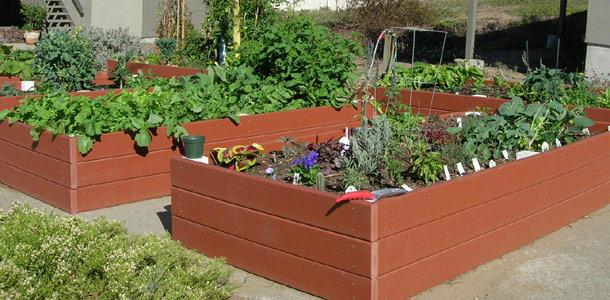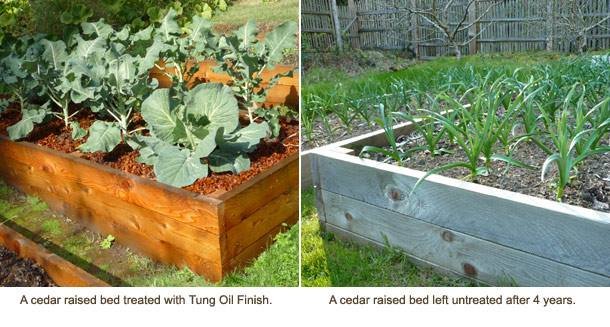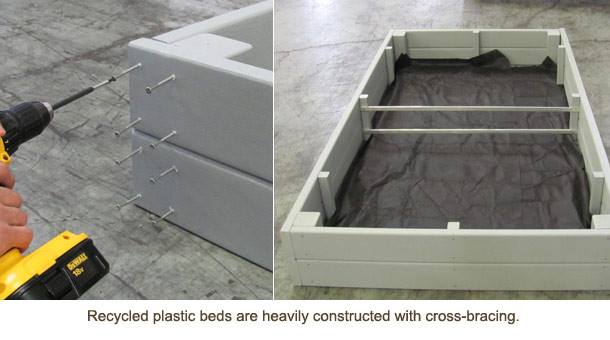Types of Garden beds and planters - materials and pros and cons. How to ...
Garden beds and planters have been traditionally made using one of several varieties of cedar, HDPE (High-density polyethylene is a new option.
Cedar is a premium wood characterized by its natural resistance to rot and its ability to hold up well to the extremes of weather. Available in a variety of species, such as Western Red Cedar, Atlantic White Cedar, Yellow Cedar, Port Orford Cedar and Juniper, cedar is the wood of choice for patio decking, fencing, outdoor furniture and many styles of garden raised beds.
Pros:
– Beautiful. Many gardeners consider the aesthetic appeal of their gardens to be as valuable as the harvested crops. Without doubt, an attractive garden feeds the soul. Wood is a natural material, and lends itself perfectly for garden beds which complement the natural beauty of the plantings.
– Weather and rot resistant. Cedar contains “extractive” chemicals, which make the wood resistant to decay. Second-growth cedar is just as rot resistant as old-growth cedar, but there should be no sapwood present in the boards, since the sapwood will rot readily. (Sapwood is the outer wood of the tree and appears milky white in contrast to the red-brown of the heartwood.)
– Easy to work. Woodworkers enjoy working with cedar because it is stable, once dry, and does not split readily at the ends. Pre-drilling is not required for simple raised bed construction.
– Relatively lightweight. Compared to other woods, cedar is relatively lightweight. This makes it easier to bring home, carry to the garden and assemble.
– Biodegradable. At the end of its lifespan, a cedar bed can be left in a low spot of your yard to slowly melt into the earth. Or the usable parts of the wood can be split into smaller pieces and used for garden stakes and trellises.
Cons:
– Color turns silver-grey, unless finished. Cedar left untreated will fade in color to a silver-grey. Depending on local sunlight conditions, this usually takes 2 – 3 years. The outside of the beds can be treated with an exterior finish such as Tung Oil Finish, which will brighten and preserve the original cedar color. If you wish to apply such a finish, it is recommended to do this before the beds are assembled and crops are planted.
HDPE (High-density polyethylene) plastic is the type used for most recycled plastic raised beds. This is an extremely durable and non-leaching plastic, commonly recycled from milk jugs, which is used not only for raised beds but for outdoor fixtures such as picnic tables, park benches, boardwalks, which must be durable, long-lasting and able to withstand the extremes of winter freezing and summer hot spells.
Pros:
– Long lasting. Raised beds made of HDPE recycled plastic are commonly guaranteed for life. Manufacturers often cite a minimum life expectancy of 50 years.
– Durable. HDPE holds up well to use. If you ram into it with your wheelbarrow, it’s unlikely to result in any damage. Recycled HDPE plastic is resistant to cracking or chipping, even in extreme weather, hot or cold.
– Stable. Does not leach. Because HDPE is a stable material it does not leach any chemicals, toxic or otherwise, into the soil within the garden bed. Also, the ‘boards’ do not shrink, twist or warp over time. HDPE does not expand or contract during periods of freezing or extreme heat.
– Available in different colors. Dyes are added to the molten HDPE to provide several color choices for the recycled plastic boards.
– Smooth finish, retains color. The appearance of recycled plastic garden beds remains consistent even after years of exposure to weather. And because the color is added before the molten plastic is poured into its mold, the color runs through the boards, so if you should scratch the sides of the beds it hardly shows because the color is the same. Light scratches can even be repaired using a small propane torch to melt the scratch closed.
– Washable. Recycled plastic garden beds can be cleaned easily by washing the surface with a wet sponge or power washer. This may not be necessary for most gardeners, but since recycled beds are available in different color choices, some colors (especially white or grey) may lend themselves to cleaning at the end of each gardening season. Recycled plastics can also be considered an investment since they improve the perceived value of your property, so cleaning the beds can be of benefit especially if you plan to resell your home in the years ahead.
– Recyclable. Should the time come to dispose of your recycled plastic beds, after decades of use, the material is still 100% recyclable. HDPE plastic is so valuable that future recycling depots may even pay a premium for this material. HDPE plastic can be easily melted down and reused for new products.
Cons:
– Heavy! When the package arrives at your door, have a few dollars on hand to tip the deliveryman and have a friend or two ready to help you move it to the garden. Recycled HDPE plastic is very heavy. However, once your bed is assembled and filled with soil the weight is no longer an issue.
– Not as much linear strength as wood. If you pick up one end of a recycled plastic board, the board will sag more than its wooden counterpart. So recycled plastic beds need some form of cross-bracing to stiffen the sides and prevent them from bowing outwards. A common solution is the use of aluminum “flat-stock”, which is just a straight bar of aluminum drilled on each end and secured to either side of the bed. Any recycled plastic raised bed 6’ or longer should have cross-bracing.
– Expensive. Because of its inherent qualities of durability and long lifespan, HDPE is considered the highest quality of recycled plastics. The raw material is costly to manufacturers of raised beds, and this cost is reflected in the price. Recycled plastic raised beds are more expensive than cedar raised beds. However, it is easy to calculate the long-term savings with recycled beds, since they do not need to be replaced.



Really good! I've made tha same for my wife's garden
Go on my page and look at my box gardens tell me what you think yours are awesome